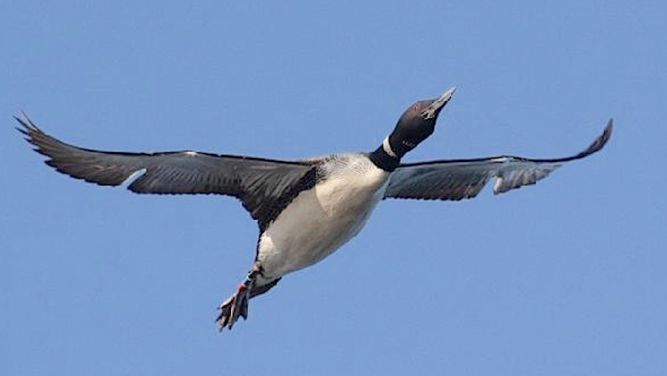
Our Loons in Winter

As fall approaches, many seasonal residents button up their camps and begin their migration to warmer climates. The loons are no exception. Loons spend summers on lakes such as these, and winters on the open ocean. This exodus begins as early as mid-August for some birds, and stretches to November for others. Adults with chicks, unsurprisingly, tend to stay later. The cutoff date, and when lingering birds find themselves in trouble, is when ice first skims over the water. This is because loons need a considerable amount of open water to act as a runway in order to take flight. They’re strong fliers once airborne; some loons migrate thousands of miles to their wintering grounds, resting on lakes along their path.

Loons, like many animals, use climate cues to determine the correct time to migrate. This poses an issue as warmer and more variable temperatures become the norm. For instance, a warm fall followed by a cold snap could leave loons trapped in the ice. Or, abnormally cold temperatures earlier on could induce a premature migration. In fact, on a survey yesterday, we encountered a banded adult whose unique color combination was different from any in our banding records. Could this visitor be a migrating bird? We aren’t sure. Varying temperatures is just one of the many possible dangers that a changing climate poses to loons, and it will be important to monitor.

The birds that face the largest hurdles are the chicks. If they do manage to survive the summer, they must migrate, often alone, to the coast. While many chicks reach a comfortably large size with time to spare, the last chicks hatching at the end of July and even the first week of August will be considerably smaller. If a loon chick isn’t mature enough to fly by the time the lakes freeze, it won’t survive.

When loons finally reach the ocean, they congregate in large groups called rafts. They’ll spend winter here, in their mottled brown winter plumage. Chicks will remain on the ocean for the first 4-5 years of their life, until they reach breeding age. Then, they’ll migrate back to the general area of the lake they hatched on. If you are bound for the coast this winter — Atlantic or Pacific — keep an ear out for loons.
Download Full Newspaper: High Res | Low Res (Details…)
<— Previous Article • Summaries • Next Article —>
©2023 by Summertime in the Belgrades. All rights reserved.